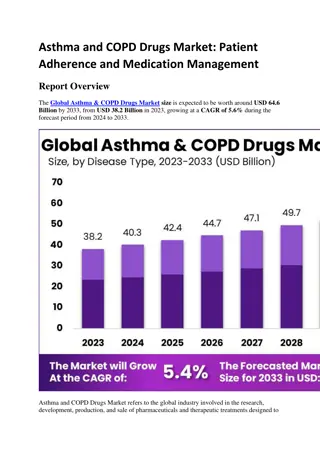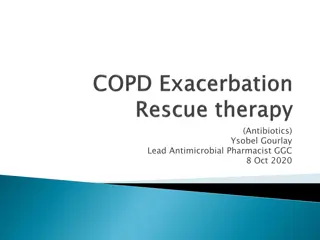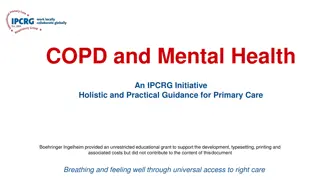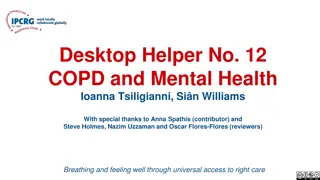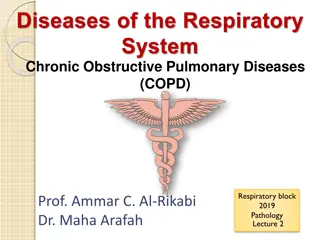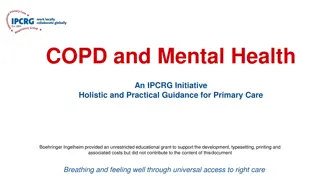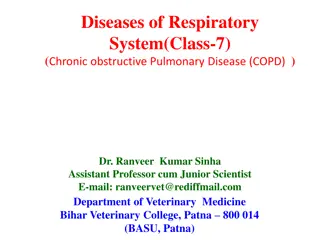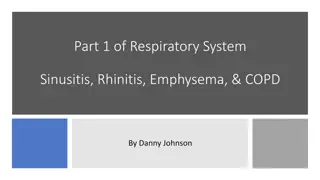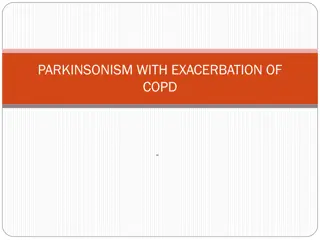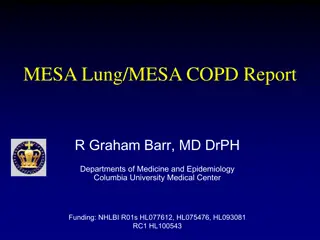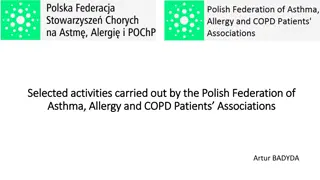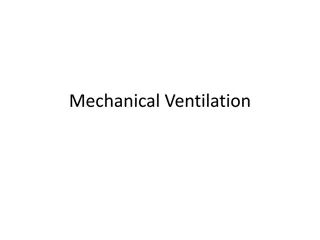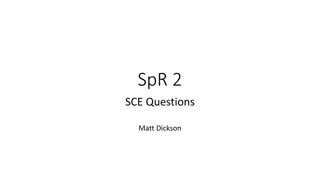COPD
COPD is a chronic lung condition characterized by progressive airflow obstruction. Major risk factor is tobacco smoking. Pathological changes lead to various physiological abnormalities. Clinical features include breathlessness, chronic cough, and more. Classification of severity is based on airflow limitation. Investigations involve lung function tests, chest radiograph, full blood count, and ECG.
Download Presentation

Please find below an Image/Link to download the presentation.
The content on the website is provided AS IS for your information and personal use only. It may not be sold, licensed, or shared on other websites without obtaining consent from the author.If you encounter any issues during the download, it is possible that the publisher has removed the file from their server.
You are allowed to download the files provided on this website for personal or commercial use, subject to the condition that they are used lawfully. All files are the property of their respective owners.
The content on the website is provided AS IS for your information and personal use only. It may not be sold, licensed, or shared on other websites without obtaining consent from the author.
E N D
Presentation Transcript
* COPD Dr MAMATHA SARTHI GPST3
*What is COPD? COPD is characterized by airflow obstruction which is usually progressive, and not fully reversible. Tobacco smoking is the major risk factor for the development of COPD. Complications include disability and reduced quality of life.
COPD *COPD is a syndrome of obstructive airflow limitation which is often caused by more than one pathological process. Commonly emphysema and bronchitis coexist. *Types of COPD include: chronic bronchitis emphysema chronic obstructive airways disease chronic airflow limitation some cases of chronic asthma bronchiectasis involvement of the lung in rheumatoid arthritis
*PATHOLOGY * pathological changes in turn results in the following physiological abnormalities: * mucous hypersecretion * ciliary dysfunction * airflow limitation and hyperinflation/air trapping * gas exchange abnormalitiesseen in advanced disease * characterised by arterial hypoxaemia with or without hypercapnia * results from an abnormal distribution of ventilation/perfusion ratios * pulmonary hypertension
*CLINICAL FEATURES *Breathlessness *chronic cough - may be intermittent and may be unproductive *regular sputum production *frequent winter bronchitis *wheeze (1)
*SIGNS *hyperinflated chest *wheeze or quiet breath sounds *purse lip breathing *use of accessory muscles *paradoxical movement of lower ribs *peripheral oedema *cyanosis *raised JVP *cachexia (1) *pink puffers" and "blue bloaters -no longer considered clinically useful.
*Classification *Classification of severity of airflow limitation in CO PD in patients with FEV1/ FVC <0.7 *Gold 1 Mild 80% *Gold 2 Moderate 50-79% *Gold 3 Severe 30-49% *Gold 4 Very Severe < 30%
*INVESTIGATIONS *lung function tests: * there is an obstructive ventilatory impairment - FEV1 < 80% predicted * the forced expiratory ratio (FEV1/FVC) is less than 70% * the residual volume is high * total lung capacity is increased *the chest radiograph may show: * hyperinflation of the lungs * bullae *the full blood count - to identify anaemia or polycythaemia *the ECG may show cor pulmonale:tall P waves *right bundle branch block *right ventricular hypertrophy
Investigations (MUST) *A chest X-ray should be arranged to exclude other pathology; a full blood count should be taken to identify anaemia or secondary polycythaemia. *The person should be offered initial inhaled treatment such as a short-acting beta-2agonist or a muscarinic antagonist additional treatments may be added depending on the person's response. *An annual influenza vaccination and a once-only pneumococcal vaccination should be arranged. *Post-bronchodilator spirometry should be measured to confirm the diagnosis of COPD *In COPD, the ratio of forced expiratory volume in 1 second to forced vital capacity (FEV1/FVC ratio) is less than 0.7.
*Differntial diagnosis *asthma *bronchiectasis *congestive cardiac failure *carcinoma of the bronchus *truberculosis *obliterative bronchiolitis *bronchopulmonary dysplasia
*Diagnosis *A diagnosis of COPD can be made if the person meets all of the following criteria: *Age older than 35 years. *Presence of a risk factor, for example current smoker, history of smoking, or occupational exposure to chemicals or dust. *Typical symptoms, such as exertional breathlessness, chronic cough, wheeze, regular sputum production, recurrent chest infection. *Signs of COPD include cyanosis, raised jugular venous pressure, cachexia, a hyperinflated chest, use of accessory muscles, pursed lip breathing, wheeze or quiet breath sounds, and peripheral oedema.
Treatment *See the Management of COPD sheet provided
All patients diagnosed with COPD should receive Smoking Cessation advice at each consultation if appropriate. Pulmonary Rehabilitation Spacers if needed-Check inhaler technique at each clinical review Referral to COPD team if appropriate Exacerbation management card offered through COPD team Annual influenza vaccination Pneumococcal vaccination once only Annual pulse oximetry for all patients , a baseline reading should be taken at diagnosis. Pulse oximetry if symptoms of severe exacerbation, FEV1 < 35% predicted or clinical signs suggestive of respiratory failure/right heart failure. Referral to Home Oxygen Team once patient is stable if SaO2 persistently 92% on breathing air. Stand-by course of antibiotics and steroids as part of a self management plan Depression screening using a validated tool as necessary Dietetic advice if BMI abnormal Consider osteoporosis prophylaxis for patients on long term oral steroids (Prednisolone 7.5mg daily or equivalent for longer than 3 months) End of Life care as appropriate Steroid card should be given to all patients on high dose ICS
REFERRAL * Referral should be considered, if appropriate: * To a respiratory specialist, for assessment for oxygen therapy if symptoms are severe or refractory, if an occupational cause is suspected, or if there are symptoms of cor pulmonale. * For pulmonary rehabilitation if the person is functionally disabled by COPD, or has had a recent hospitalization for an acute exacerbation. * To a physiotherapist if the person has excessive sputum, to learn the use of positive expiratory pressure masks, and the 'active cycle of breathing' technique. * To social services and occupational therapy if they have difficulties with activities of daily living. * To psychological services if the person has anxiety or depression related to symptoms of COPD.
*Useful Contact numbers *Community COPD Team ACE gateway Tel: 0300 0032 144 *Pulmonary Rehabilitation referrals need to be made via email to: * Home Oxygen Teamacecic.communitygateway@nhs.net *Chest Unit CHUFT, Tel: 01206 746461 /746462 Fax: 01206 742080 *Respiratory Nurses, CHUFT, Tel: 01206 742261



